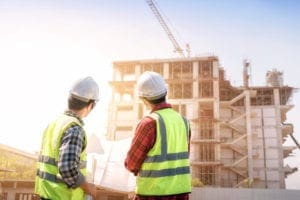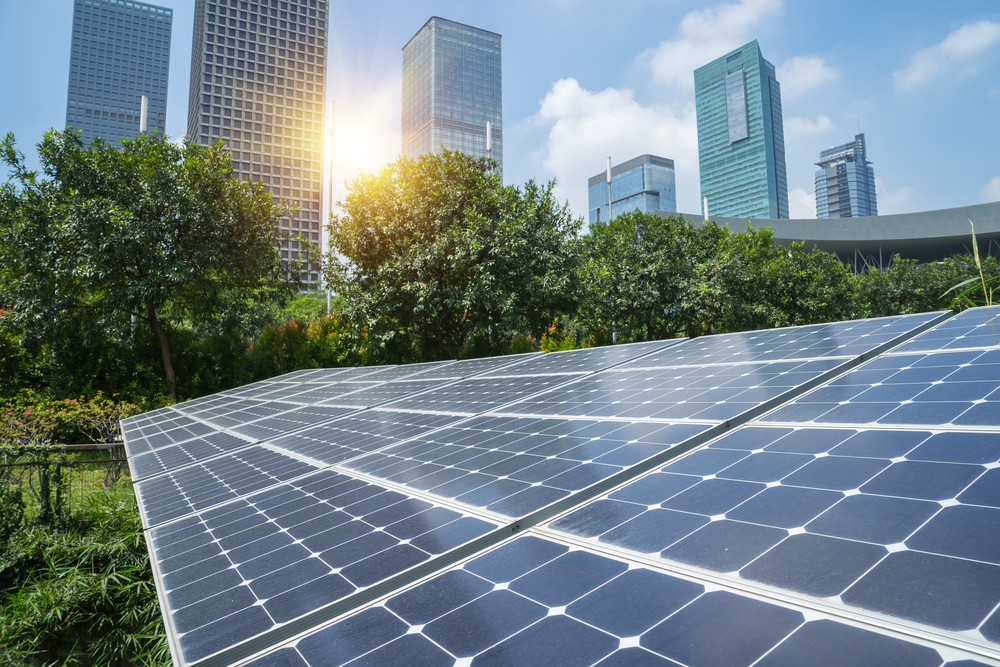As America’s energy production gets cleaner, with renewables now providing 22 percent of the nation’s power versus 3 percent in 2011[i], today’s material and digital innovations enable next-level efficiency improvements to substantially reduce energy demand, emissions and associated climate impacts, not to mention $80 billion a year spent on wasted energy nationwide[ii].
At Atlas, we consider energy and resource efficiency as fundamental to sustainable development, delivering social, environmental and economic benefits across transportation, industrial, commercial, and residential sectors.
IMPROVING EFFICENCY IN THE BUILDINGS WHERE WE LIVE AND WORK
 Among the most accessible ways we can unlock value is to improve efficiency in buildings where we live and work. Commercial and residential buildings account for 76 percent of electricity use, 40 percent of all energy consumption and about one-third of the world’s greenhouse gases[iii]. And, while new facilities convey benefits of carbon-neutral “green” design, far greater value remains to be realized by retrofitting the vast number of existing buildings in our nation’s inventory. Here’s why:
Among the most accessible ways we can unlock value is to improve efficiency in buildings where we live and work. Commercial and residential buildings account for 76 percent of electricity use, 40 percent of all energy consumption and about one-third of the world’s greenhouse gases[iii]. And, while new facilities convey benefits of carbon-neutral “green” design, far greater value remains to be realized by retrofitting the vast number of existing buildings in our nation’s inventory. Here’s why:
- Physical building improvements like insulation, windows, and roofing benefit from newer, high-performance materials and mechanical equipment that cut energy consumption and costs associated with heating and cooling[iv].
- In new construction, advances in material science and reuse contribute substantial efficiency improvements, while also reducing waste, costs and emissions across the supply chain.
- And for new and existing structures alike, digital technologies are taking efficiency to new heights, with management controls that automatically adjust heating, lighting, and a host of variables to reduce energy waste. In the commercial sector, these technologies leverage real-time analytics to connect buildings with supporting infrastructure systems, enabling additional improvements that maximize energy, water and transportation efficiencies as well as productivity.
Whether planning new buildings or improving existing ones, systems-thinking and operational training help owners boost efficiency by linking facilities, operators and users with surrounding infrastructure and natural assets for better performance. Innovations like digital twins, automation and data-driven management make system-wide improvements possible by providing the foundation for autonomous, uber-efficient smart buildings, and the realization of truly integrated smart cities, leveraging all available digital technologies, intelligence, and operating systems on the power grid to source, deploy, store, and optimize energy efficiency and carbon capture across every aspect of management.
REDUCING ENERGY COSTS AND CARBON IMPACTS
While occupant behaviors ultimately determine the effectiveness of efficiency efforts, building and public utility systems increasingly offer connections and controls on occupants’ personal devices to inform individuals and encourage behaviors that reduce energy costs and carbon impacts.
 As advancements in technology converge with present-day shifts in the way people live and work, the payoff potential of building efficiency has never been greater. After the COVID-19 pandemic accelerated remote working trends, office vacancy rates in America’s largest city centers climbed from 9 percent a few years ago to 15 percent this year[v]. Now, companies realizing benefits of hybrid working models are revisiting space requirements to reduce their leasing costs. For owners looking to redevelop commercial spaces to address these market dynamics, efficiency presents an opportunity. For instance, persistent demand for downtown housing in many cities is driving the conversion of vacant office space to residential and other uses. In 2021, Rentcafe found 41 percent of apartment conversions in urban markets happened in buildings originally slated for office use[vi].
As advancements in technology converge with present-day shifts in the way people live and work, the payoff potential of building efficiency has never been greater. After the COVID-19 pandemic accelerated remote working trends, office vacancy rates in America’s largest city centers climbed from 9 percent a few years ago to 15 percent this year[v]. Now, companies realizing benefits of hybrid working models are revisiting space requirements to reduce their leasing costs. For owners looking to redevelop commercial spaces to address these market dynamics, efficiency presents an opportunity. For instance, persistent demand for downtown housing in many cities is driving the conversion of vacant office space to residential and other uses. In 2021, Rentcafe found 41 percent of apartment conversions in urban markets happened in buildings originally slated for office use[vi].
In 2022, Atlas supported a private developer in completing an energy efficiency plan to qualify the conversion of a Jackson, Miss. high-rise office building to a 184-unit affordable housing community under the Mississippi Home Investment Partnership program. In addition to establishing a usage baseline, we recommended upgrades to the building’s energy and water utilities to achieve savings beyond the 20 percent threshold requested. By modeling energy consumption and cost projections for the whole building as well as the new individual units, we were able to validate efficiency upgrades intended to reduce tenants’ utility-cost burdens below the average 8.6 percent of household earnings borne by low-income families[vii].
LEGISLATION INCENTIVIZING EFFICIENCY INVESTMENTS
Alongside these trends, two key pieces of legislation will incentivize efficiency investments, offering faster payback and higher returns for communities and investors alike:
1. The Bipartisan Infrastructure Law (BIL) signed in November 2021 will significantly boost green construction and energy-efficient development efforts. The BIL provides more than $62 billion to Department of Energy (DOE) efficiency programs and more than $3.5 billion for state-run programs, including $225 million in grants for states and others to implement building energy codes; grants and loans for residential weatherization and decarbonization; and $250 million in loans and grants for energy efficiency audits, upgrades, and retrofits of residential and commercial buildings. Finally, the DOE will administer the $550 million Energy Efficiency and Conversation Block Grant Program to enable local and tribal governments to implement energy-use and emission-reduction strategies, including efficiency improvements in the transportation and building
2. August’s Inflation Reduction Act will infuse record amounts of capital for energy efficiency in residential and commercial buildings, with $370 billion in climate and clean energy investments that could cut greenhouse gas emissions up to 43 percent below 2005 levels by 2030. The act also offers expanded tax credits to encourage building owners and developers to make carbon-reducing efficiency improvements in new and existing
 In another example of federal policy incentivizing energy efficiency and equitable economic development, Atlas has supported dozens of projects in the U.S. Department of Housing and Urban Development’s Rental Assistance Demonstration (RAD) program facilitating public-private investments to rehabilitate an aging stock of public housing. Our housing and energy team worked with dozens of public housing authorities and private developers to plan life-enhancing improvements in affordable housing communities, including installation of energy-efficient systems and upgrades to meet green building standards. These efforts reduced tenants’ utility costs while also demonstrating the economic viability of efficiency investments for housing authorities and developers.
In another example of federal policy incentivizing energy efficiency and equitable economic development, Atlas has supported dozens of projects in the U.S. Department of Housing and Urban Development’s Rental Assistance Demonstration (RAD) program facilitating public-private investments to rehabilitate an aging stock of public housing. Our housing and energy team worked with dozens of public housing authorities and private developers to plan life-enhancing improvements in affordable housing communities, including installation of energy-efficient systems and upgrades to meet green building standards. These efforts reduced tenants’ utility costs while also demonstrating the economic viability of efficiency investments for housing authorities and developers.
Atlas is working to take such investments further, conducting reviews with public housing authorities to identify energy efficiency savings and associated emissions reductions enabling monetization of carbon credits and 179D tax credits to support public housing development partnerships. These efforts attract additional capital for public housing and efficiency improvements.
BUILDING A MORE RESILIENT FUTURE
When it comes to fulfilling these opportunities, our industry has a critical role to play. Like never before, we can connect people, places and systems to deliver the full promise of efficiency in every aspect of Environmental, Social and Governance (ESG) improvement. At Atlas, we bring a unique complement of expertise to advance the ESG efforts of those we serve—from testing, to environmental and engineering solutions, to program-management—for sustainable outcomes and a more resilient future.
References:
[i] U.S. Energy Information Administration (EIA)
[ii] U.S. Department of Energy (DOE) Office of Energy Efficiency and Renewable Energy (EERE)
[iii] EIA
[iv] Stanford University Buildings Research
[v] CommercialEdge National Office Report, August 2022
[vi] RentCafe 2021 Adaptive Reuse Report, October 2021
[vii] EERE
